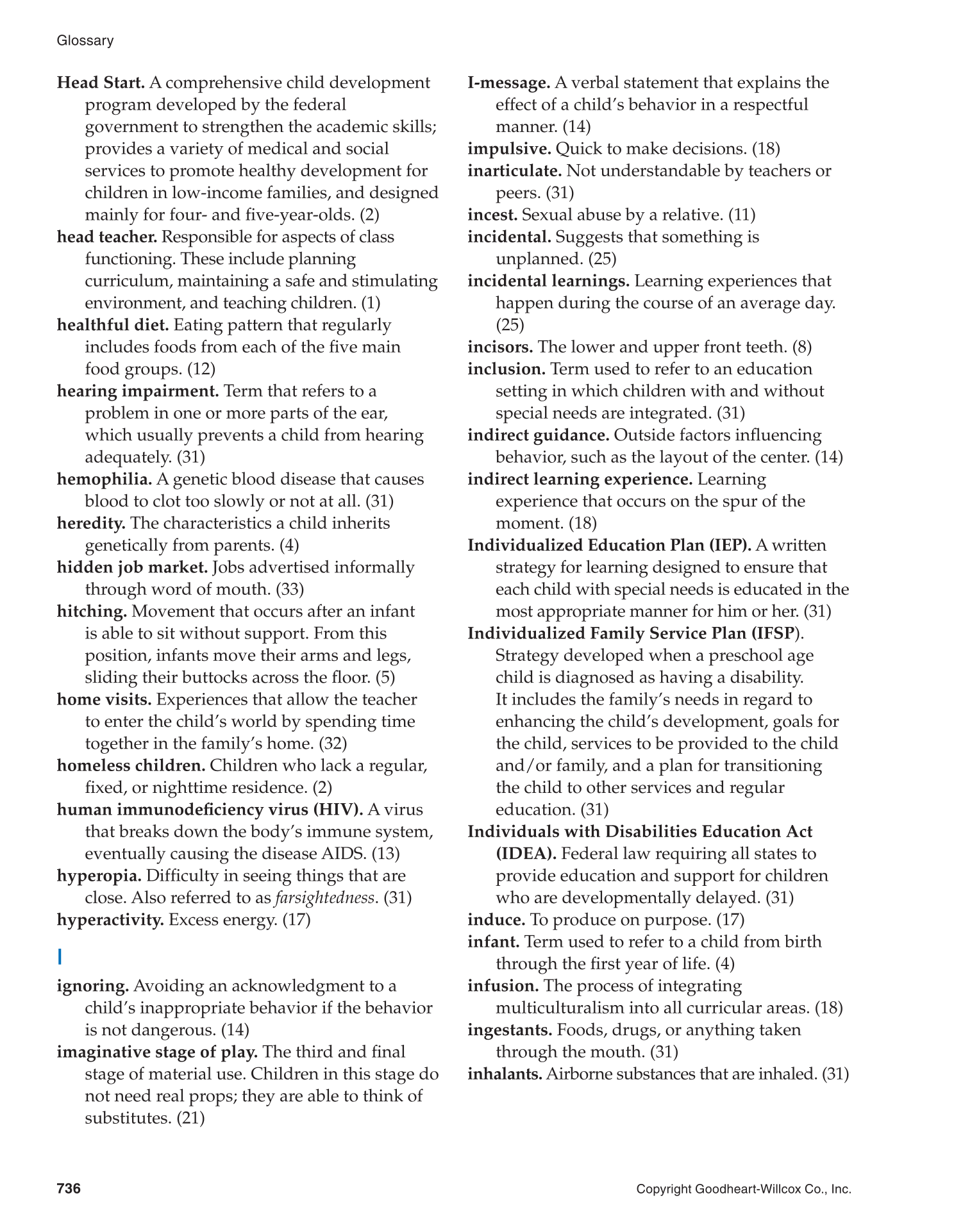736
Copyright Goodheart-Willcox Co., Inc.
Head Start. A comprehensive child development
program developed by the federal
government to strengthen the academic skills;
provides a variety of medical and social
services to promote healthy development for
children in low-income families, and designed
mainly for four- and fi ve-year-olds. (2)
head teacher. Responsible for aspects of class
functioning. These include planning
curriculum, maintaining a safe and stimulating
environment, and teaching children. (1)
healthful diet. Eating pattern that regularly
includes foods from each of the fi ve main
food groups. (12)
hearing impairment. Term that refers to a
problem in one or more parts of the ear,
which usually prevents a child from hearing
adequately. (31)
hemophilia. A genetic blood disease that causes
blood to clot too slowly or not at all. (31)
heredity. The characteristics a child inherits
genetically from parents. (4)
hidden job market. Jobs advertised informally
through word of mouth. (33)
hitching. Movement that occurs after an infant
is able to sit without support. From this
position, infants move their arms and legs,
sliding their buttocks across the fl oor. (5)
home visits. Experiences that allow the teacher
to enter the child’s world by spending time
together in the family’s home. (32)
homeless children. Children who lack a regular,
fi xed, or nighttime residence. (2)
human immunodefi ciency virus (HIV). A virus
that breaks down the body’s immune system,
eventually causing the disease AIDS. (13)
hyperopia. Diffi culty in seeing things that are
close. Also referred to as farsightedness. (31)
hyperactivity. Excess energy. (17)
I
ignoring. Avoiding an acknowledgment to a
child’s inappropriate behavior if the behavior
is not dangerous. (14)
imaginative stage of play. The third and fi nal
stage of material use. Children in this stage do
not need real props; they are able to think of
substitutes. (21)
I-message. A verbal statement that explains the
effect of a child’s behavior in a respectful
manner. (14)
impulsive. Quick to make decisions. (18)
inarticulate. Not understandable by teachers or
peers. (31)
incest. Sexual abuse by a relative. (11)
incidental. Suggests that something is
unplanned. (25)
incidental learnings. Learning experiences that
happen during the course of an average day.
(25)
incisors. The lower and upper front teeth. (8)
inclusion. Term used to refer to an education
setting in which children with and without
special needs are integrated. (31)
indirect guidance. Outside factors infl uencing
behavior, such as the layout of the center. (14)
indirect learning experience. Learning
experience that occurs on the spur of the
moment. (18)
Individualized Education Plan (IEP). A written
strategy for learning designed to ensure that
each child with special needs is educated in the
most appropriate manner for him or her. (31)
Individualized Family Service Plan (IFSP).
Strategy developed when a preschool age
child is diagnosed as having a disability.
It includes the family’s needs in regard to
enhancing the child’s development, goals for
the child, services to be provided to the child
and/or family, and a plan for transitioning
the child to other services and regular
education. (31)
Individuals with Disabilities Education Act
(IDEA). Federal law requiring all states to
provide education and support for children
who are developmentally delayed. (31)
induce. To produce on purpose. (17)
infant. Term used to refer to a child from birth
through the fi rst year of life. (4)
infusion. The process of integrating
multiculturalism into all curricular areas. (18)
ingestants. Foods, drugs, or anything taken
through the mouth. (31)
inhalants. Airborne substances that are inhaled. (31)
Glossary
